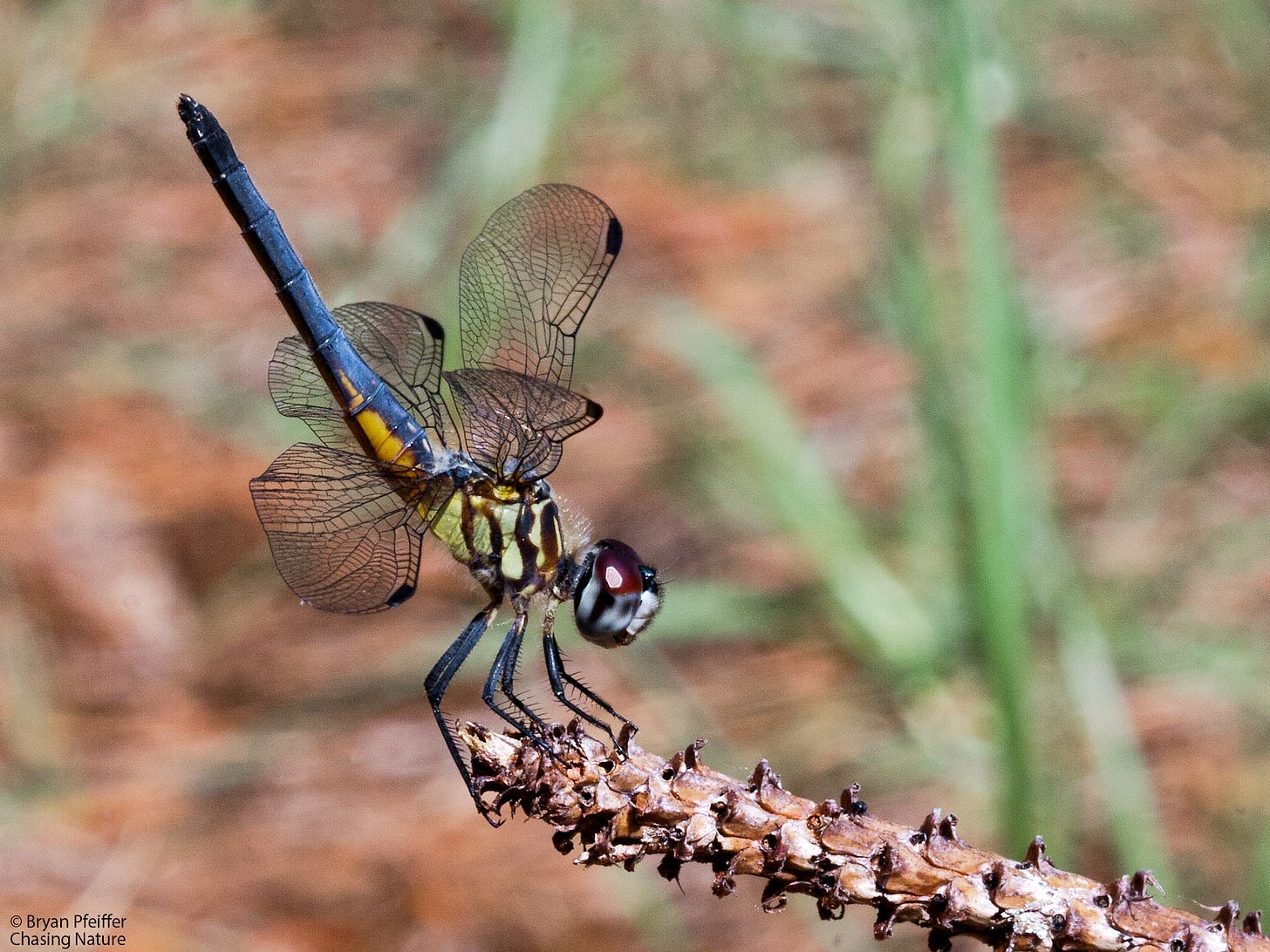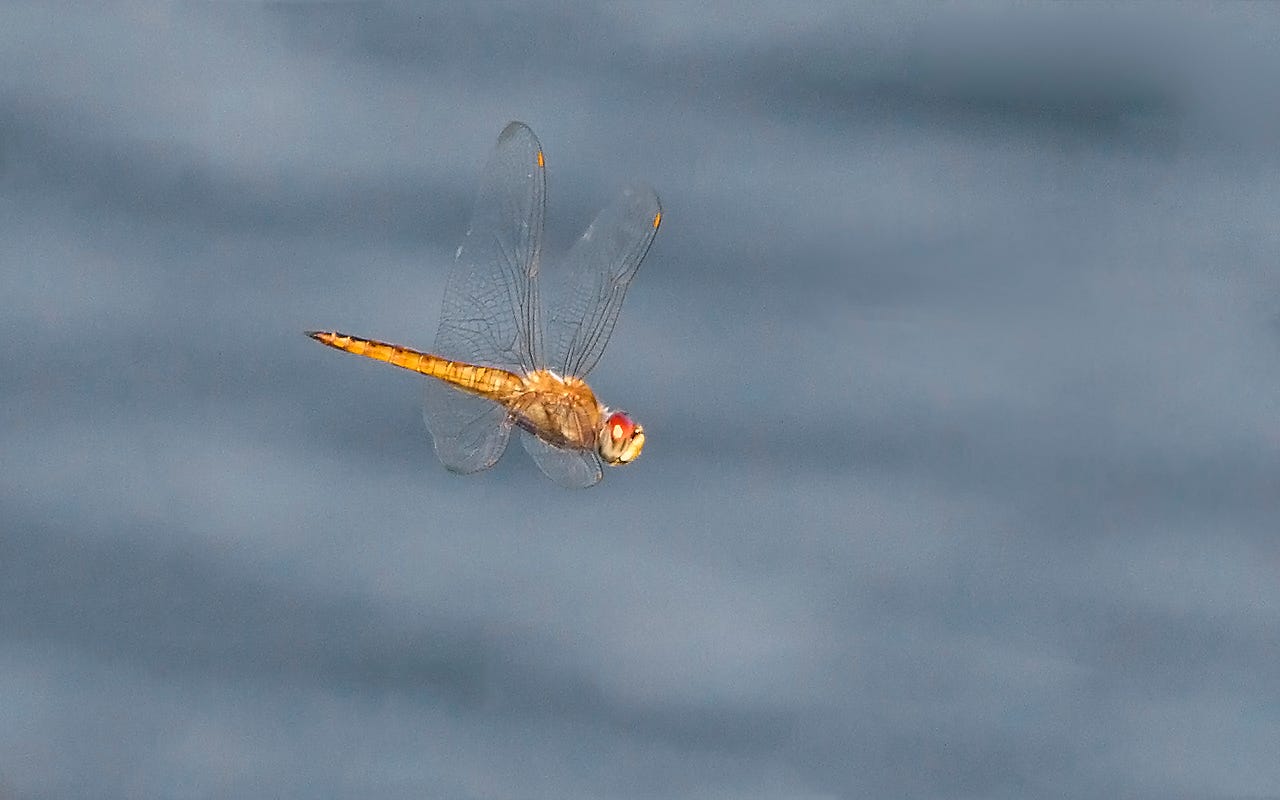A Wild Swarm of Dragonflies
What Might We Learn from a Crowded Beach and a Folk Festival in Rhode Island?
IN PERHAPS the most crude and magnificent description of their lives, dragonflies basically do three things: fly around, kill insects, and have crazy sex. (Sometimes they have sex while flying around, but not while killing insects).
Sure, dragonflies do other things. They themselves try not to be killed, for example, and certain species migrate great distances, even across oceans. Sometimes dragonflies swarm, which happened this past Saturday at Misquamicut Beach in Rhode Island, where the dragonflies were neither killing things nor having sex. They were instead flying in numbers and behavior that to the best of my knowledge has never been witnessed here in North America. The dragonflies also unwittingly revealed a few things about human nature.
In watching videos from the beach, those of us who study or celebrate dragonfly distribution and behavior soon recognized that this flight was remarkable for two reasons. First is abundance. Dragonflies are capable of swarming by the hundreds or thousands or more, but the videos reveal a staggering flight at the beach. It is all but impossible to estimate how many dragonflies were in the swarm, but neither my colleagues nor I can recall anything like it — and all of us wish we had been there to see it. (Don’t forget to turn on the audio below.)
Second was a surprise dragonfly species: Blue Dasher (Pachydiplax longipennis), which is about an inch-and-a-half long and fairly ornate as dragonflies go. No doubt other species flew in the swarm, but its abundance of dashers was shocking. For the most part, Blue Dashers live out their lives — from egg to nymph to adult — at vegetated ponds, where they dash around, kill and eat smaller insects, and have crazy dragonfly sex (about which I shall write in another essay). Although Blue Dasher is one of the most common and widely distributed dragonfly species in the U.S., it has not been known to swarm in numbers like this or to undertake peregrinations.
When I first heard about the swarm on the radio, I had assumed it comprised two or three well-known migratory species, including Wandering Glider (Pantala flavescens). The color of gold with a story to match, Wandering Glider is the most widespread and ambitious dragonfly on Earth, flying over every continent except Antarctica (give it time). I routinely see swarms of them along the New England coast and offshore out to sea, and they typically wander (from parts unknown) into my home city of Montpelier, Vermont, in early August.
When they wander among people in Japan and other parts of Asia, the gliders and other dragonflies can be welcomed as symbols of courage and spirit. Their acrobatic flights, predatory behavior, vivid coloration, even their perching on people now and then, have made dragonflies worthy expressions of experience in haiku.
From my shoulder
to the Buddha’s shoulder—
the dragonfly
— Kobayashi Issa
Here in the west, however, dragonflies can be known as “caballito del diablo” (the devil’s little horse) and “devil’s darning needles.” As is their wont, the news media, desperate for clicks like zombies for flesh, baited reports with “dragonfly apocalypse,” “biblical plague,” “invasion,” “attack,” and “hoards.” Among my favorites was “Beachgoers scream, run for cover as thousands of dragonflies swarm them” above a video clip of nearly everyone relaxing on the beach as the dashers dashed around. (By the way, during the swarm on the beach, which reportedly lasted about five minutes, never did I see in the videos any insect collide with any human; dragonflies are good like that.)
To be fair, dragonflies do hold status in the western zeitgeist: art, jewelry, tattoos, microbrews, spirituality, model organisms for science. Among the scenes I like most in the videos were the kids, with little minnow nets, trying unsuccessfully to catch a few dashers, and other people photographing them perched on beach accoutrements.
For perspective on the Rhode Island event, I called Dennis Paulson, a world authority on dragonflies and countless other living things, who at 86 has seen nearly all there is to see among these insects. Never had he seen anything like this. Always inquisitive, Dennis noticed that the vast majority of the swarm was made up of mature male Blue Dashers — females were basically nowhere to be seen. (Mature male dashers display sea-green eyes, a blue abdomen, and a yellow-striped thorax; females are muted in their markings.) This could indicate that the provenance of the swarm was not necessarily an unusually high emergence of Blue Dashers near the Rhode Island coast this year, whose males and females, for whatever reason, suddenly vacated their site (or sites).
Were these males explorers, pioneers, assembled in search of new breeding sites? Were they pursuing some massive flight of prey species? If so, why weren’t females among them pursuing prey as well? Did weather play a role? “There’s a lot we don’t know about odonates,” said Dennis, a biologist who truly knows Odonata, the insect order consisting of dragonflies and damselflies.
Here in New England this year we’ve had various other extraordinary natural events — good and bad: a massive flight of Red Admiral butterflies and a total solar eclipse in April, the northern lights in May, record-breaking heat in June, and destructive thunderstorms in July (especially here in Vermont).
And now we’ve witnessed yet another wonderful, wild performance: dragonflies doing something we may never see again — and nonetheless strive to understand. One thing is certain about this swarm, which you can see in a video that day from the Newport Folk Festival just up the Rhode Island coast from the beach. Even insects that fly around, kill things, and have crazy sex can also bring us joy. Have a look for yourself (and definitely click the icon for audio).

Postscripts
Perhaps more than any dragonfly in North America, Blue Dashers perch in plain view in a kind of territorial positioning for real estate and resources. (It’s the reason they were landing on peoples’ fingertips at the folk festival.) That propensity for perching and their relative abundance across the U.S. (except the upper Great Plains and Rocky Mountains) make Blue Dasher the most photographed dragonfly in the world on the iNaturalist platform. To help you find your own Blue Dasher this summer, here’s an iNaturalist map of more than 100,000 sightings over the years.
Okay, by way of literary license, I sorta lied about the exclusivity of flying around and killing insects. Dragonflies also kill things as aquatic larvae, which we call nymphs. In the water, they take other aquatic insects (including other dragonflies) and small amphibians and fish. In most cases, dragonflies spend far more of their lives underwater as nymphs than in the air as adults. It’s been said that a dragonfly making the transformation from aquatic nymph to free-flying adult is a bit like a snapping turtle becoming a peregrine falcon. That final image below is of an Elfin Skimmer (Nannothemis bella), the smallest dragonfly in North America, less than an inch long, freshly emerged from — and perched upon — the outer skin (exuvia) that housed it as a nymph in a fen here in Vermont.
Among his various books and publications, Dennis Paulson has written the informative and beautiful Dragonflies and Damselflies: A Natural History, published by Princeton University Press. ISBN: 9780691180366
The translation of that Issa haiku comes from the fine book Dragonfly Haiku by Kobayashi Issa, Ken Tennessen, and the late Scott King. Red Dragonfly Press. ISBN: 9781937693985
Finally, please do not lose faith: As I’ve been promising (and myself click-baiting), I’ve got essays about liverwort sex and zombie snails in the works for you this month. It would have been tough this week to pass up on those dragonflies.











Wait, the mind-blowing Rhode Island swarm were BLUE DASHERS?! That's completely nuts. Thank you so much for this timely post, because I was planning to tell people at the Odonata class that I'm teaching tonight that they were probably darners and gliders! Because that's what would make sense. Amazing, thank you again for this.
Bryan, Any evidence of the swarm being picked up on weather radar? If so, where they came from and where they were headed might be tracked.